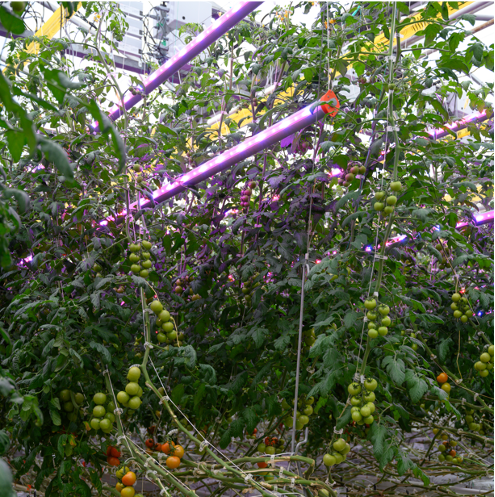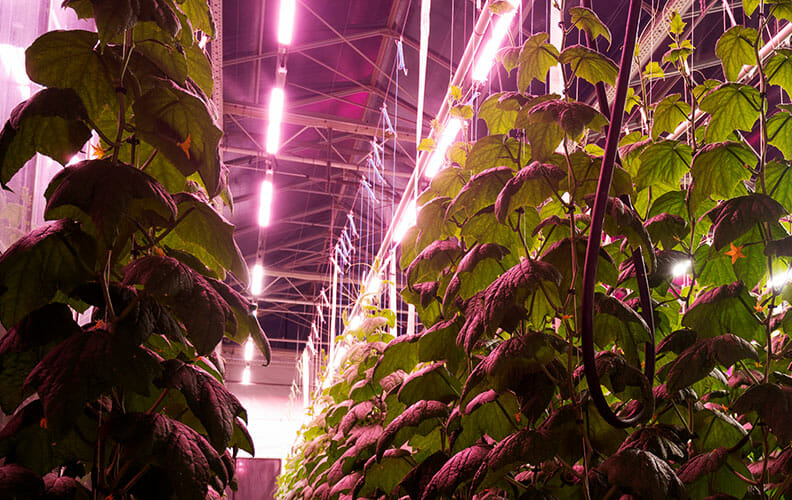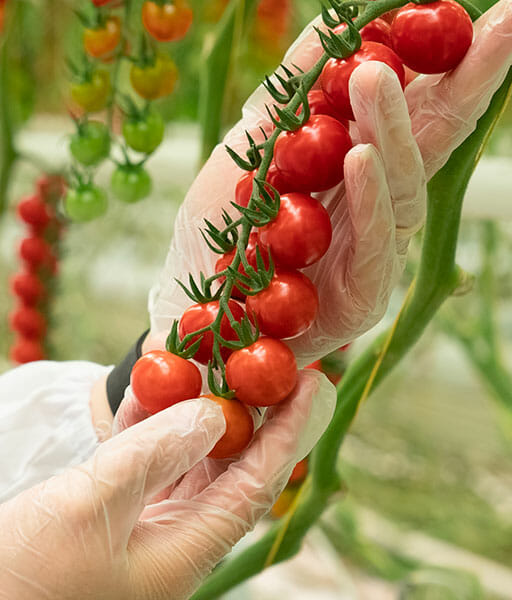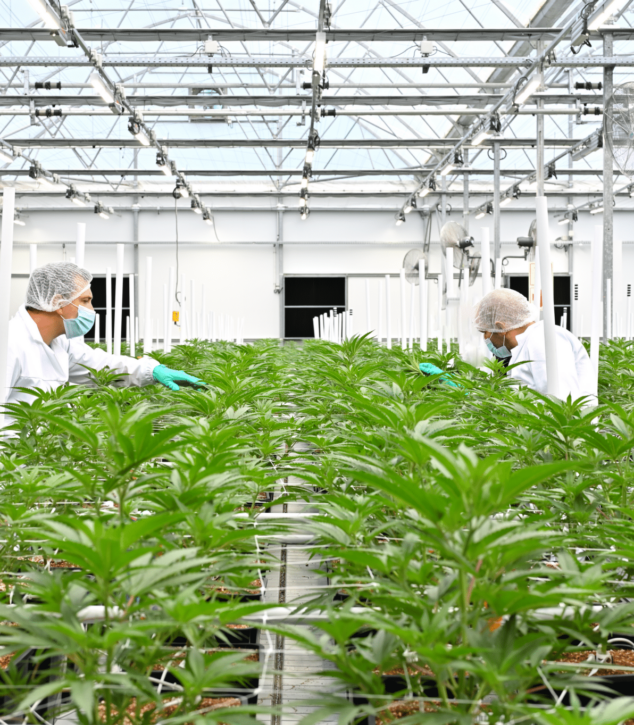Intercanopy lighting study: A Fluence research trial to determine the influence of light intensity and light distribution on cucumbers and tomatoes
Crop focus: Vine crops, tomato and cucumber
Environment: Greenhouse production
Study location: Wageningen University and Research, The Netherlands
Greenhouse growers of vine crops have long seen the benefit of adding supplemental top lighting as part of their cultivation strategy, particularly through the winter months. By adding top light such as the VYPR series, growers have achieved higher yields and year-round fruit consistency. But what happens when you add lighting within the plant canopy? This is exactly the question the Fluence global research team sought out in their latest study.
In this study, Fluence’s research team partnered with Wageningen University and Research to determine the effect of moving one third of the total light sum to intercanopy light, in both a traditional intensity of 250 µmol·m-2·s-1, referred to in this research as low intensity, as well as a high intensity treatment at 375 µmol·m-2·s-1.
The study showed that not only the different light intensities, but also the locations of light sources did in fact impact fruit yield: the treatment with the highest total light intensity of 375 µmol·m-2·s-1, comprising of 250 µmol·m-2·s-1 top light and 125 µmol·m-2·s-1 of intercanopy light, produced the highest number of fruits in both the cucumber and tomato studies and the highest increase compared to the same PPFD toplight only.
The Experiment
What placement of my light is most effective for fruit production?
To understand the impact of light intensity, the study applied two different light intensities (250 µmol·m-2·s-1 and 375 µmol·m-2·s-1) to the crops, each with two different distributions. One distribution applied all of the light at the top of the canopy, the other distributed light with two thirds of the light applied at the top of the canopy and the remaining third applied in the plant canopy. The study was executed as a randomized complete block design with three replicates of each light treatment for each crop in order to achieve statistically significant results.
Figure 1: Graphic depicts the placement of the top light and the intercanopy light in the experiment.
The following set points were defined during the trial:
Table 1: Light distribution study key set points
| Parameter | Cucumber | Tomato |
|---|---|---|
| Cultivar | Hi Power and Skyson | Merlice and Brioso |
| Light treatment | 250 and 375 µmol·m-2·s- toplight, plus same treatments with 1/3 of total light sum as interlight | |
| Plant density | 2.74 plants/m2 | At 250 µmol·m-2·s-1: 2.74 plants/m2 At 375 µmol·m-2·s-1: 4.11 plants/m2 |
| Timeline | Start: October Final Harvest: February | Start: October Final Harvest: March |
If you are interested in learning about the experiment’s environmental parameters, please access our on-demand webinar or contact our team.
Experiment Note: Cucumber pruning strategy
In the study Fluence partnered with a global crop consulting group, Vortus bv Greenhouse Consultants to ensure commercial crop production parameters were included in the research. One of the essential practices leveraged during the experiment was flower pruning.
In the cucumber study, under the low-intensity treatment (250 µmol·m-2·s-1) between 50% to 66% of the flowers were removed throughout the study. To start, every other flower was removed to reduce the plant load for the low light intensity treatments and keep plant and fruit growth in balance. Half-way through the experiment (mid-December to early January), pruning included removing every two out of three flowers from the vine. The assumption was under the low-intensity the plant can feed less fruits given the inputs and by pruning the plant was able to allocate resources appropriately.
Under the high-intensity treatment (375 µmol·m-2·s-1), 33% of the flowers were removed from the start to the end. Every third flower was removed from the vine entirely. The assumption under the high-intensity treatment was the plant can feed more fruits during development given the inputs, therefore more flowers were left on the vine.
Results and Analysis: Cumulative Yield
Crop: Cucumber
Cultivar: Hi Power
The highest fruit yield was collected under the highest light treatment at 375 µmol·m-2·s-1 when light is distributed both at the top and in the canopy.
When comparing the results under the 375 µmol·m-2·s-1 treatment, cucumber cultivar ‘Hi Power’ produced 25% more fruit as compared to the top light only treatment (Figure 2). Cultivar ‘Skyson’ had the same trend lines with a 17% increase in cumulative yield.
Figure 2: Fruit yield results for cucumbers, cv. ‘Hi Power’
Crop: Tomato
Cultivar: Brioso
The same trend was observed in the tomato study. The highest fruit yield was collected under the highest light treatment at 375 µmol·m-2·s-1 when light is distributed both at the top and in the canopy.
When comparing the results under the 375 µmol·m-2·s-1 treatment, Brioso produced 32% more fruit as compared to the top light only treatment (Figure 3). Merlice had the same trend lines with a 30% increase in cumulative yield.
Figure 3: Fruit yield for tomatoes. cv. ‘Brioso”

Interested in diving into the data?
In addition to yield, researchers evaluated the impact of light distribution on plant morphology and plant quality. The data showed only one outlying result: in the cucumber study, as you add more light the plant was more compact, resulting in shorter vines. There were no significant changes to plant morphology in the tomato study, and no differences were noted in the cucumber or tomato quality in this study.
Key Takeaway: You can add more plant yield when you apply more light to the plant and distribute the light at the top of the canopy and within the canopy.
It is well known by growers and scientists alike, by increasing light intensity, you increase plant biomass. But what is less known is what happens when you take that same amount of light and distribute it at different positions of the canopy.
The key takeaway reveals the location of the light does in fact impact overall fruit yield. As seen in Figure 2, even under the 250 µmol·m-2·s-1 treatment, cucumber yield increased slightly (17%) when light was introduced into the canopy.
For growers looking to include intercanopy lighting in their cultivation strategy, the most effective placement is with a higher light intensity placed at the top and within the plant canopy.
Resources for Success
Read More
About The Research Group

Fluence research
The Fluence Research team conducts studies through partnerships with leading research groups around the world while also conducting research in-house at the company’s Photobiology and Research Lab in Austin, Texas. Fluence partners with industry consultants to advise on the commercial viability of the team’s research studies while concurrently proving our lighting solutions at commercial scale through grower case studies led by Fluence’s Horticultural Services team.

Research Partner
More than 100 years of experience
Located at the center of horticulture innovation in the Netherlands
Cultivate under modern greenhouses and partner with crop consultants

Research Partner
Global cultivation support consulting group with over 35 years of experience
Collaborative approach leveraging research to apply to commercial crop production
Specialize in vegetable fruits, leafy greens, cut flowers, breeding, propagation, and organic production











